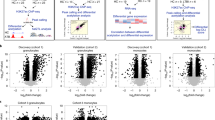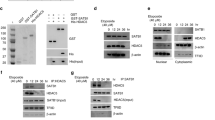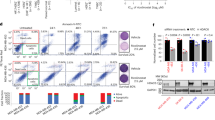Abstract
T helper 1 (Th1) immunity is typically viewed as a critical adaptation by vertebrates against intracellular pathogens. Identifying novel targets to enhance Th1 cell differentiation and function is increasingly important for anti-infection immunity. Here, through small-molecule screening focusing on epigenetic modifiers during the in vitro Th1 cell differentiation process, we identified that the selective histone deacetylase 6 (HDAC6) inhibitors ricolinostat and nexturastat A (Nex A) promoted Th1 cell differentiation. HDAC6-depleted mice exhibit elevation of Th1 cell differentiation, and decreased severity of Listeria monocytogenes infection. Mechanistically, HDAC6 directly deacetylated CBP-catalyzed acetylation of signal transducer and activator of transcription 4 (STAT4)-lysine (K) 667 via its enzymatic activity. Acetylation of STAT4-K667 is required for JAK2-mediated phosphorylation and activation of STAT4. Stat4K667R mutant mice lost the ability to normally differentiate into Th1 cells and developed severe Listeria infection. Our study identifies acetylation of STAT4-K667 as an essential signaling event for Th1 cell differentiation and defense against intracellular pathogen infections, and highlights the therapeutic potential of HDAC6 inhibitors for controlling intracellular pathogen infections.
Similar content being viewed by others
Log in or create a free account to read this content
Gain free access to this article, as well as selected content from this journal and more on nature.com
or
Data availability
RNA-seq datasets are deposited in the Gene Expression Omnibus (GEO) with accession number GEO: GSE146253. We collected ChIP-seq and ATAC-seq data from the GEO public resource (http://www.ncbi.nlm.nih.gov/geo) and the accession numbers are GSM550303, GSM550304, GSM2828376, GSM2828377, GSM2828378, GSM2828379, GSM836118, GSM836120, GSM994512, and GSM994513. All of the full length original western blots for these results are provide in Supplementary File 1.
References
Kaplan MH, Sun YL, Hoey T, Grusby MJ. Impaired IL-12 responses and enhanced development of Th2 cells in Stat4-deficient mice. Nature 1996;382:174–7.
Thierfelder WE, van Deursen JM, Yamamoto K, Tripp RA, Sarawar SR, Carson RT, et al. Requirement for Stat4 in interleukin-12-mediated responses of natural killer and T cells. Nature 1996;382:171–4.
Wagner RD, Steinberg H, Brown JF, Czuprynski CJ. Recombinant interleukin-12 enhances resistance of mice to Listeria monocytogenes infection. Micro Pathogenesis. 1994;17:175–86.
Wieczorek M, Ginter T, Brand P, Heinzel T, Krämer OH. Acetylation modulates the STAT signaling code. Cytokine Growth F R 2012;23:293–305.
Nijhuis L, Peeters JGC, Vastert SJ, van Loosdregt J. Restoring T Cell Tolerance, Exploring the Potential of Histone Deacetylase Inhibitors for the Treatment of Juvenile Idiopathic Arthritis. Front Immunol. 2019;10:151.
Nusinzon I, Horvath CM. Positive and negative regulation of the innate antiviral response and beta interferon gene expression by deacetylation. Mol Cell Biol. 2006;26:3106–13.
Into T, Inomata M, Niida S, Murakami Y, Shibata K-I. Regulation of MyD88 aggregation and the MyD88-dependent signaling pathway by sequestosome 1 and histone deacetylase 6. The J Biol Chem. 2010;285:35759–69.
Kovacs JJ, Murphy PJM, Gaillard S, Zhao X, Wu J-T, Nicchitta CV, et al. HDAC6 regulates Hsp90 acetylation and chaperone-dependent activation of glucocorticoid receptor. Mol cell. 2005;18:601–7.
Yan B, Liu Y, Bai H, Chen M, Xie S, Li D, et al. HDAC6 regulates IL-17 expression in T lymphocytes: implications for HDAC6-targeted therapies. Theranostics 2017;7:1002–9.
de Zoeten EF, Wang L, Butler K, Beier UH, Akimova T, Sai H, et al. Histone deacetylase 6 and heat shock protein 90 control the functions of Foxp3(+) T-regulatory cells. Mol Cell Biol. 2011;31:2066–78.
Laino AS, Betts BC, Veerapathran A, Dolgalev I, Sarnaik A, Quayle SN, et al. HDAC6 selective inhibition of melanoma patient T-cells augments anti-tumor characteristics. J Immunother Cancer. 2019;7:33.
Fukumoto T, Fatkhutdinov N, Zundell JA, Tcyganov EN, Nacarelli T, Karakashev S, et al. HDAC6 Inhibition Synergizes with Anti-PD-L1 Therapy in ARID1A-Inactivated Ovarian Cancer. Cancer Res. 2019;79:5482–9.
Pamer EG. Immune responses to Listeria monocytogenes. Nat Rev Immunol. 2004;4:812–23.
Zhan Y, Cheers C. Control of IL-12 and IFN-gamma production in response to live or dead bacteria by TNF and other factors. J Immunol (Baltim, Md: 1950). 1998;161:1447–53.
Moreno-Gonzalo O, Ramírez-Huesca M, Blas-Rus N HDAC6 controls innate immune and autophagy responses to TLR-mediated signalling by the intracellular bacteria Listeria monocytogenes. 2017; 13: e1006799.
Zhang YS, Xin DE, Wang Z, Song X, Sun Y, Zou QC, et al. STAT4 activation by leukemia inhibitory factor confers a therapeutic effect on intestinal inflammation. The EMBO journal. 2019;38.
Nguyen KB, Watford WT, Salomon R, Hofmann SR, Pien GC, Morinobu A, et al. Critical role for STAT4 activation by type 1 interferons in the interferon-gamma response to viral infection. Science 2002;297:2063–6.
Nguyen HN, Noss EH, Mizoguchi F, Huppertz C, Wei KS, Watts GF, et al. Autocrine Loop Involving IL-6 Family Member LIF, LIF Receptor, and STAT4 Drives Sustained Fibroblast Production of Inflammatory Mediators. Immunity 2017;46:220–32.
Wei L, Vahedi G, Sun H-W, Watford WT, Takatori H, Ramos HL, et al. Discrete roles of STAT4 and STAT6 transcription factors in tuning epigenetic modifications and transcription during T helper cell differentiation. Immunity 2010;32:840–51.
Vahedi G, Takahashi H, Nakayamada S, Sun H-W, Sartorelli V, Kanno Y, et al. STATs shape the active enhancer landscape of T cell populations. Cell 2012;151:981–93.
Nakayamada S, Kanno Y, Takahashi H, Jankovic D, Lu KT, Johnson TA, et al. Early Th1 cell differentiation is marked by a Tfh cell-like transition. Immunity 2011;35:919–31.
Weinstein JS, Laidlaw BJ, Lu Y, Wang JK, Schulz VP, Li N, et al. STAT4 and T-bet control follicular helper T cell development in viral infections. J Exp Med. 2018;215:337–55.
Wada H, Masuda K, Satoh R, Kakugawa K, Ikawa T, Katsura Y, et al. Adult T-cell progenitors retain myeloid potential. Nature 2008;452:768–72.
Luc S, Luis TC, Boukarabila H, Macaulay IC, Buza-Vidas N, Bouriez-Jones T, et al. The earliest thymic T cell progenitors sustain B cell and myeloid lineage potential. Nat Immunol. 2012;13:412–9.
Henry CJ, Ornelles DA, Mitchell LM, Brzoza-Lewis KL, Hiltbold EM. IL-12 produced by dendritic cells augments CD8 + T cell activation through the production of the chemokines CCL1 and CCL17. J Immunol. 2008;181:8576–84.
Vacaflores A, Freedman SN, Chapman NM, Houtman JC. Pretreatment of activated human CD8 T cells with IL-12 leads to enhanced TCR-induced signaling and cytokine production. Mol Immunol. 2017;81:1–15.
Wilson DC, Matthews S, Yap GS. IL-12 signaling drives CD8 + T cell IFN-gamma production and differentiation of KLRG1 + effector subpopulations during Toxoplasma gondii Infection. J Immunol. 2008;180:5935–45.
Ma L, Huang C, Wang XJ, Xin DE, Wang LS, Zou QC, et al. Lysyl Oxidase 3 Is a Dual-Specificity Enzyme Involved in STAT3 Deacetylation and Deacetylimination Modulation. Mol cell. 2017;65:296–309.
Skene PJ, Henikoff JG, Henikoff S. Targeted in situ genome-wide profiling with high efficiency for low cell numbers. Nat Protoc. 2018;13:1006–19.
Bergstrom KS, Morampudi V, Chan JM, Bhinder G, Lau J, Yang H, et al. Goblet Cell Derived RELM-beta Recruits CD4 + T Cells during Infectious Colitis to Promote Protective Intestinal Epithelial Cell Proliferation. PLoS Pathog. 2015;11:e1005108.
Acknowledgements
We are grateful to Yu Zhang for providing us with the Hdac6–/– mice. Jingjing Wang and Qi Li for technical help in L. monocytogenes infection experiments. We are grateful to Bing Su for manuscript review and discussion.
Funding
YZ was supported by the Young Scientists Fund of the National Natural Science Foundation Grant of China (32000620). This work was supported by National Natural Science Foundation Grant of China (81820108023, U1603284 and 81530083), Young Scientists Fund of the National Natural Science Foundation Grant of China (31700789), National Key Research and Development Program of China (2016YFC1302402), and the Priority Academic Program Development of Jiangsu Higher Education Institutions (PAPD).
Author information
Authors and Affiliations
Contributions
YZ and DX contributed to the experimental design, conductions of experiments, and manuscript preparation. ZW and WP performed the experiments, data analysis and manuscript preparation. YZ, JL, MX, NC, JZ, YJ, MC and YW assisted with the experiments. MC and JY provided technical assistance. ZC, XL and LC contributed to the data analysis and manuscript writing. YC was involved in the conception of the research, experimental design, data analysis, and manuscript preparation.
Corresponding author
Ethics declarations
Competing interests
The authors declare no competing interests.
Ethics approval
All animal experiments were performed in compliance with the guide for the care and use of laboratory animals and were approved by the institutional biomedical research ethics committee of Soochow University.
Additional information
Publisher’s note Springer Nature remains neutral with regard to jurisdictional claims in published maps and institutional affiliations.
Edited by Y. Shi
Rights and permissions
About this article
Cite this article
Zhang, Y.S., Xin, D.E., Wang, Z. et al. Acetylation licenses Th1 cell polarization to constrain Listeria monocytogenes infection. Cell Death Differ 29, 2303–2315 (2022). https://doi.org/10.1038/s41418-022-01017-9
Received:
Revised:
Accepted:
Published:
Issue date:
DOI: https://doi.org/10.1038/s41418-022-01017-9
This article is cited by
-
Restoring mucosal barrier homeostasis by in situ formation of a living-synthetic therapeutic coating
Nature Communications (2025)
-
Single-cell deconvolution algorithms analysis unveils autocrine IL11-mediated resistance to docetaxel in prostate cancer via activation of the JAK1/STAT4 pathway
Journal of Experimental & Clinical Cancer Research (2024)



